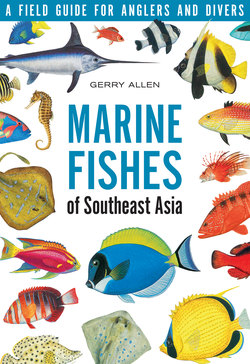Читать книгу Marine Fishes of South-East Asia - Gerry Allen - Страница 11
На сайте Литреса книга снята с продажи.
ОглавлениеFAUNAL COMPOSITION
Most of the region’s reef and shore fishes can be broadly described as being of Indo-Pacific origin. In other words, they belong to the overall reef fish community that ranges across the vast reaches of the tropical Indian and Pacific oceans. Although individual species, and particularly the mixture of species present, vary greatly from one locality to the next in this huge region, there is a general faunal theme that pervades. Nearly all families and many genera are widely distributed throughout the region. Also the dominant (i.e., most speciose) families tend to be the same regardless of locality. Dominant groups across this region usually include such families as gobies, wrasses, damselfishes, gropers, moray eels, cardinalfishes, and surgeonfishes.
The reason for the region’s relative homogeneity in faunal composition is at least partly explained by examining the life cycle of reef fishes. With few exceptions most species have a pelagic larval stage which is transported by ocean currents for variable distances depending on hydrological conditions and duration of the larval period. Until recently the length of larval life for most fishes was an unknown factor, but thanks to otolith aging techniques our knowledge in this area is rapidly expanding. Essentially this technique consists of counting daily microscopic growth rings that appear on the bones of the inner ear (otoliths). We now know that the larval duration is highly variable, ranging from just a few days up to nearly two months, with an average length of about 3-4 weeks. Although the adults of most reef fishes are highly home-ranging or territorial, a homogeneous gene-pool is maintained over a broad area by the dispersal capabilities of the larval stage.
Many Indo-Australian reef fishes are distributed widely across the Indian and West and Central Pacific oceans. Species such as the Racoon Butterflyfish (Plate 55-13) and Pacific Gregory (Pl. 66-12) range from the shores of eastern Africa to the Hawaiian Islands and a few others such as the Moorish Idol (Pl. 92-9) and Longnose Hawkfish (Pl. 67-18) extend even farther, to the coast of the Americas. Indeed, throughout the Indo-Pacific region a significant segment of the fauna consists of similar widespread species. Another important component of the fauna consists of species that have more limited regional distributions. A number of species such as the Honey-Head Damsel (Pl. 61-8) and Rainbow Monocle Bream (Pl. 51-12) are mainly confined to what biogeographers refer to as the Indo-Australian Archipelago, which encompasses the Malay Peninsula, Indonesia, Philippines, northern Australia, and Melanesia. At the bottom end of the scale, a few species such as the Banggai Cardinalfish (Pl. 34-7) have an extremely limited range. It is only found among a small group of islands off central-east Sulawesi. This fish, and others that are similarly restricted, usually lack a pelagic larval stage, which prevents their dispersal.
